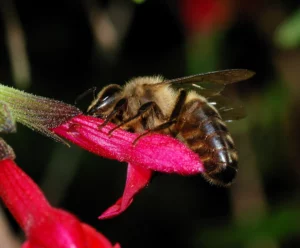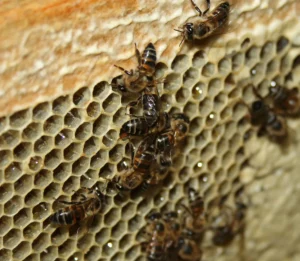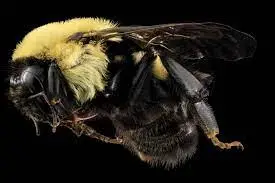Bees are uniquely suited to pollinate, assisting plants in growing, reproducing, and producing food. Let us discuss a few of the most common bees below.
- American bumblebee
- Western honey bee
- Common eastern bumblebee
- Africanized bee
- European dark bee
- Italian bee
- Cape honey bee
- Golden Northern Bumble bee
- Western Bumble bee
- Brown belted bumblebee
- Russian honey bee
- Buckfast bee
- Violet carpenter bee
- Tawny mining bee
- Mason bee
American bumblebee
A common species of bumblebee known for having a large tongue is the American bumblebee. These are social bees. Its features include a yellow thoracic dorsum, a black posterior, three initial alternating black and white tergal segments, a long and lanky malar space, and short hair. It also has a darker colour pattern.
Western honey bee
Of the 7–12 species of honey bees found globally, the western honey bee is the most prevalent. The western honey bee is eusocial, just like all other honey bee species. It builds colonies with a single fertile female, lots of normally non-reproductive females, and a small percentage of fertile males, which make up the majority of the population.
Common eastern bumblebee
The most frequent bumblebee in much of eastern North America is the common eastern bumblebee. They may reside in rural areas, suburban communities, and even urban areas because of their high flexibility. They are excellent pollinator species, which has increased their commercial use by the greenhouse sector.
Africanized bee
Africanized bee are lethal stinging insects that, when agitated and aggressive, have been known to chase individuals for more than a quarter of a mile. They resemble domestic honeybees in appearance, with the exception that they are significantly smaller. They have darker brown bars framed in golden yellow.
European dark bee
A variety of the western honey bee is the European dark bee. They have a stocky build, a lot of brown hair on their thorax and abdomen, and an overall dark colouring. From a distance, they appear primarily black, or in the case of mellifera, a rich dark brown.

Italian bee
It is believed that the continental portion of Italy is where the Italian honey bee first appeared. On the abdomen, they have bands that are both brown and yellow. There are three distinct hues of Italian bees: leather, a bright yellow (golden), and a very pale yellow (Cordovan). They exhibit a tremendous propensity for reproduction and are exceedingly productive.
Cape honey bee
The Cape honey bee is distinct from other honey bee subspecies because workers can produce female, diploid eggs by a process called thelytoky. By pollinating crops and generating honey in the Western Cape region of South Africa, they significantly contribute to the country’s agriculture and economy.

Golden Northern Bumble bee
North America is the native home of the golden northern bumble bee species. Its abdomen and thorax are yellow in hue. As pollinators of several flowering plants, these bees play the most important function in the ecology.
Western Bumble bee
In general, Western bumblebees are foragers. They are regarded as superior pollinators since they do not rely solely on one variety of flower. In addition, bumblebees have lower flight levels than most other bees and can fly in milder temperatures. In addition, bumblebees engage in “buzz pollination“.
Brown belted bumblebee
The brown belted bumblebee may live in a variety of habitats, including meadows, marshes, farm fields, and even heavily populated cities. In addition to milkweed, prairie clovers, echinaceas, loosestrife, bergamot, pickerel weeds, rudbeckias, goldenrods, clovers, and vetches, this bee also feeds on loosestrife and bergamot.

Russian honey bee
A honeybee from the Primorsky Krai region of Russia is referred to as a Russian honeybee. Due to severe declines in bee populations brought on by parasitic mite infestations, this strain of bee was introduced into the country by the USDA’s Honeybee Breeding, Genetics & Physiology Laboratory in Baton Rouge, Louisiana, in 1997. It has since been used in breeding programmes to enhance current stocks.
Buckfast bee
Brother Adam crossed various subspecies and strains to produce the honey bee variety known as the Buckfast bee. The consistency is outstanding when it comes to traits that directly affect the performance and financial worth of the race.
Violet carpenter bee
The violet carpenter bee is one of the biggest bees in Europe and the most widespread species of carpenter bee in Europe. It builds its nests on dead wood, like the majority of other species in the Xylocopa genus. It is not overly aggressive and only attacks if necessary.
Tawny mining bee
A species of sand bee native to Europe is the tawny mining bee. The females are 8–10 mm length, while the males are 10–12 mm long. The female has black hair on its head and ventral surface and fox-red hair on the dorsal surface of its thorax and abdomen. With golden-brown or reddish-brown hairs, some long white hairs on the face, and a tooth on each mandible, the male is less recognisable.
Mason bee
The term “mason bee” is now frequently used to refer to species of bees belonging to the Megachilidae family’s genus Osmia. The name “mason bee” refers to the habit of these bees to build their nests in naturally available spaces like fissures in stones or other small, dark niches using mud or other “masonry” materials.
Conclusion
In order to wrap up this post, we can say that bees are essential to preserving the natural equilibrium. The biodiversity on which we all rely for survival includes bees. They offer premium foods like honey, royal jelly, and other items like beeswax, propolis, and honey bee venom.
Also Read:
- Are proteins soluble
- Function of cytosine
- Tick characteristics
- Competitive inhibition examples
- Where does bacteria live
- Is dna replication antiparallel
- Spider examples
- Smooth endoplasmic reticulum function
- What chromosomes are made up of
- Phytoplankton examples

Hi…I am Sadiqua Noor, done Postgraduation in Biotechnology, my area of interest is molecular biology and genetics, apart from these I have a keen interest in scientific article writing in simpler words so that the people from non-science backgrounds can also understand the beauty and gifts of science. I have 5 years of experience as a tutor.
Let’s connect through LinkedIn-